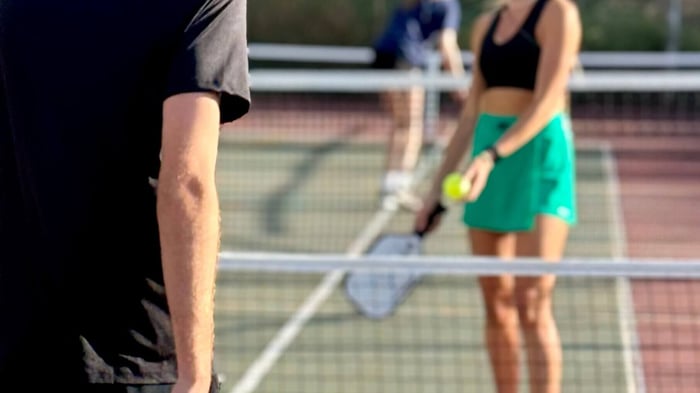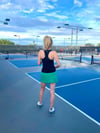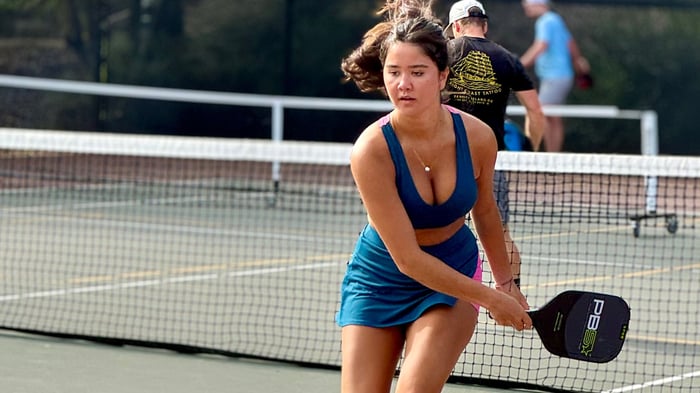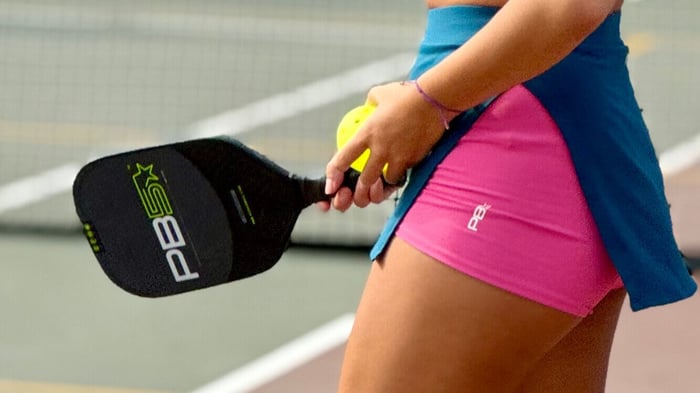Key takeaways:
Embrace the unique challenges spring weather brings with adaptive techniques and smart positioning.
Adapting to different outdoor surfaces like concrete, asphalt, and acrylic-coated courts requires adjusting to new ball bounce patterns and modifying your footwork.
Modifying your technique for outdoor conditions requires adjusting shot selection and serving strategy to account for wind and different court surfaces, focusing initially on consistency over power.
As spring nears, it's the perfect moment to shake off the cold and bring fresh energy to your pickleball game. Those indoor winter sessions may have kept your skills sharp, but stepping outside changes everything. Sunshine, breeze, different court feels—it's a whole new ballgame. Your game needs a few smart adjustments, but with the right gear and mindset, you'll be crushing it in the sunshine in no time.
At PB5star, we’re here to support your transition into springtime play with court-ready apparel, performance-driven gear, and practical tips to adjust your technique, routine, and mindset for the season ahead.
Court surface transitions
As you transition to playing outdoors more often in the springtime, the biggest change you’re going to face is the actual court. Different surfaces affect ball bounce, player movement, and overall strategy—which means that you’ll have to adapt to a different style of play. Here are some things you’ll have to keep in mind as you prepare for outdoor play.
Moving from indoor gym floors to outdoor surfaces
Indoor gym floors provide consistent ball bounce and grip for your shoes, while outdoor courts vary widely. Concrete courts are hard with predictable bounce but can be tough on joints. Asphalt surfaces may have subtle irregularities that affect ball movement. Dedicated pickleball courts (often acrylic-coated) offer the most consistent outdoor play. However, they may still differ from your winter indoor experience.
Before playing a full game, spend 10-15 minutes hitting basic shots and moving around the court to get a feel for how the surface responds. Outdoor shoes with appropriate tread patterns provide better traction than indoor court shoes on rougher outdoor surfaces.
How different surfaces affect ball bounce and player movement
Each surface type changes how the ball behaves and how you'll need to move. Concrete creates faster, higher bounces with consistent response, while asphalt produces a slightly slower bounce with occasional unpredictability. Acrylic-coated courts are similar to indoor play but generally faster than gym floors. Tennis courts are often slower and have a higher bounce due to the textured surface.
Outdoor surfaces create more impact on your joints during quick movements, and stopping and starting can be more difficult on rougher outdoor surfaces. Direction changes require more control to prevent slipping, and the distance covered tends to increase as outdoor courts may be slightly larger than indoor spaces.
Footwork adjustments for various outdoor surfaces
As the court surface changes, your footwork is the first change you’ll need to make. When first playing outdoors, take smaller, more controlled steps. This helps you adjust to different friction levels and prevent overcommitting to movements. Lower your center of gravity slightly more by bending your knees in your ready position. This improves stability on less predictable surfaces.
The split step (small hop before moving toward the ball) becomes even more important outdoors. Practice timing this move to help maintain balance when reacting to shots affected by wind or unusual bounces. After hitting a shot, focus on controlled recovery steps back to position rather than quick jumps or hops that might be less stable outdoors.
Physical conditioning for spring pickleball
Transitioning to outdoor play requires preparing your body for different physical demands. The following conditioning exercises will help build the specific strength, stamina, and flexibility needed for spring pickleball.
Rebuilding stamina after winter
Due to space constraints, indoor winter play often involves shorter points and less movement. As you move outdoors, you must rebuild your endurance for the longer rallies and larger courts.
Gradual progression: Start with 30-minute sessions and add 15 minutes each week until you reach your typical playing duration. This prevents burnout and reduces the risk of injury.
Interval training: Mix short bursts of high-intensity movement (30 seconds) with recovery periods (90 seconds). This mimics the stop-start nature of pickleball rallies and builds both aerobic and anaerobic fitness.
Cross-training options: Swimming, cycling, or using an elliptical machine can maintain cardiovascular fitness without stressing your joints.
Stretching routines specific to outdoor pickleball
Outdoor play demands more from your body, particularly in areas prone to tightness after winter play. Stretching and conditioning your body for the impact of outdoor courts will reduce the risk of injuries and keep you fit to play the entire season.
Dynamic warm-up (5-10 minutes before play):
Arm circles (forward and backward)
Torso twists
Side-to-side lunges
Light jogging or marching in place
Wrist rotations and flexion/extension
Post-play flexibility (Hold each stretch for 20-30 seconds):
Shoulder stretches (to prevent rotator cuff issues)
Hamstring stretches (helps with quick directional changes)
Calf stretches (critical for court movement)
Lower back stretches (reduces strain from bending for low shots)
Practice drills for a smooth transition
These targeted drills will help you adapt to the nature of outdoor pickleball and build the skills needed to succeed on the court faster.
Boundary line drill: Place balls at various positions along the boundary lines and practice moving to each one, touching it, and returning to center court. This helps reestablish your spatial awareness of the larger outdoor court dimensions.
Wind assessment drill: Practice hitting 10 dinks, 10 drives, and 10 lobs in different wind conditions, noting how each shot is affected. Spend 5 minutes after each session writing down what you learned about shot adjustment in those conditions.
Shadow footwork: Practice moving around the court to imaginary shots without using a ball, focusing on adapting your footwork to the outdoor surface. This builds muscle memory for the different friction and responses of outdoor courts.
Court coverage progression: Start at the non-volley zone line and have a partner hit balls to progressively wider court areas. Begin with close, central shots and gradually expand to more difficult placements. This helps you adjust to the distances you'll need to cover outdoors.
Technique modifications for outdoor pickleball
Small adjustments to your shots and strategy can significantly improve your outdoor playing experience. The following modifications to your technique will help you maintain control despite variables like wind, sun, and different court surfaces.
Shot selection changes for outdoor courts
Outdoor courts affect how the ball moves, requiring different shot choices. Here are a few things to consider for each shot.
Dinks: On outdoor courts, dinks (soft shots that barely clear the net) may be less effective in windy conditions. Focus on consistent contact and adjust your target spot to account for drift.
Drives: Driving shots (fast, low hits) can be more effective outdoors as the ball may move faster on concrete or asphalt. However, wind can make them less predictable.
Lobs: Lob shots (high-arcing shots that go over opponents' heads) become trickier outdoors. When using lobs, account for wind direction and add extra height when hitting into the wind.
Third shot drop: This shot (a soft shot hit by the serving team on the third shot of a rally) becomes more challenging outdoors. Practice controlling your touch to adjust to different conditions.
Serving adaptations for outdoor conditions
Your serve is your first opportunity to control the point. Here’s how you can tweak your serving technique to account for outdoor play.
Ball adjustment: Outdoor balls are heavier and have larger holes than indoor balls. Practice your serve with proper outdoor balls before your first game.
Service depth: Aim to serve deeper when playing outdoors—landing the ball closer to your opponent’s baseline gives them less time to react. Outdoor surfaces speed up the ball, so a deep serve helps you stay in control from the start.
Consistency over power: Focus on consistent, reliable serves rather than power serves when first transitioning outdoors. Wind and surface differences can throw off hard serves, so start with control and add power gradually as you gain comfort with outdoor conditions.
Service grip: Grip your paddle slightly tighter when serving outdoors to maintain better control in windy conditions—especially on high-toss or spin serves where wind can throw off timing and contact.
By adjusting these aspects of your technique, you'll be able to maintain better control of your game as you move from indoor winter play to the more variable conditions of outdoor spring pickleball.
Gear check: prepping your equipment
Your equipment needs just as much attention as your technique when preparing for spring outdoor pickleball sessions. A quick gear check can save you frustration later when courts are busy and you're eager to play!
Paddle maintenance and care
Winter play can be tough on your paddle, especially if you've knocked balls around in heated indoor facilities. Examine your paddle for any hairline cracks, loose grip tape, or edge guards coming loose. A quick wipe-down with a damp cloth removes accumulated grime, while grip tape might need replacement if it's slick or peeling. A comfortable grip is important for critical "kitchen" shots (the non-volley zone near the net).
Ball switch-up
Indoor and outdoor pickleballs aren't interchangeable. Outdoor balls are smaller, have more holes, and are slightly heavier to withstand wind conditions. They play faster and are more durable on rough outdoor surfaces. If you've been playing with indoor balls all winter (with larger, fewer holes), practice with outdoor balls before competitive play—they'll behave differently on serves and during rallies.
Comfortable performance apparel
Your outdoor sessions call for smart clothing choices to handle both the heat and UV exposure. Opt for lightweight and breathable clothing that helps you cool down faster.
If you’re wondering where to find new apparel for spring, PB5star's moisture-wicking shirts are your best bet! They’ll keep you cool and comfortable during longer outdoor rallies. Bonus tip: reach for light colors that reflect better for those sunny spring afternoons; it’s a minor change that can really save you some extra degrees!
Footwear fundamentals
Those court shoes that served you well indoors might not be ideal for outdoor play. Look for shoes that offer:
Better durability for rougher surfaces
Enhanced lateral support for quick directional changes
Appropriate traction patterns for concrete or asphalt
PB5 Court2 shoes are lightweight and provide excellent traction and control. They also feature reinforced premium rubber to handle intense play at outdoor courts.
Sun protection essentials
Pack a breathable hat with a brim like PB5star's Signature Cap, UV-protective sunglasses (which also help track the ball against bright skies), and sweat-resistant sunscreen. A small towel clipped to your bag helps manage perspiration during play—something you likely didn't need as much indoors.
Springing into action
Spring is the perfect time to refresh your game and embrace new challenges on the court. By making a few smart adjustments to your gear, movement, and mindset, you’ll not only ease the transition from winter play—you’ll come back stronger, sharper, and ready for whatever the season brings.
At PB5star, we’re here to support every part of your game with high-performance gear and court-ready apparel built for all conditions. Step onto the court with confidence, knowing you’ve got the style, comfort, and quality to play your best—no matter the season.







